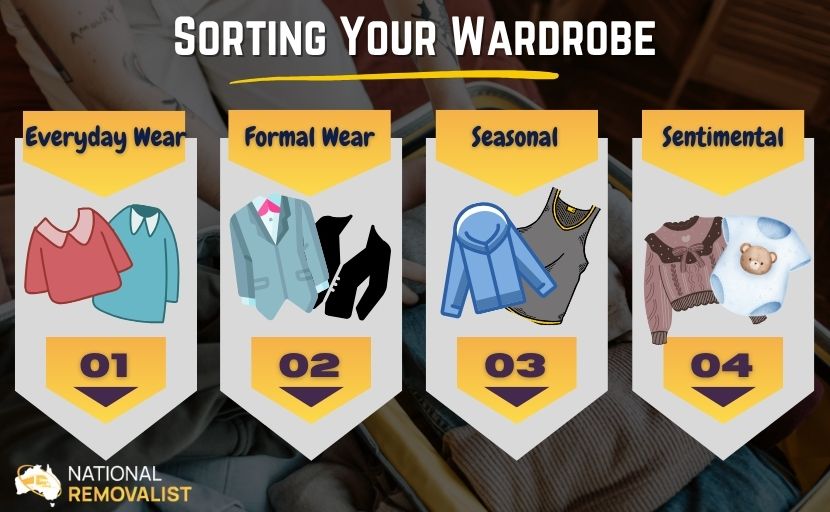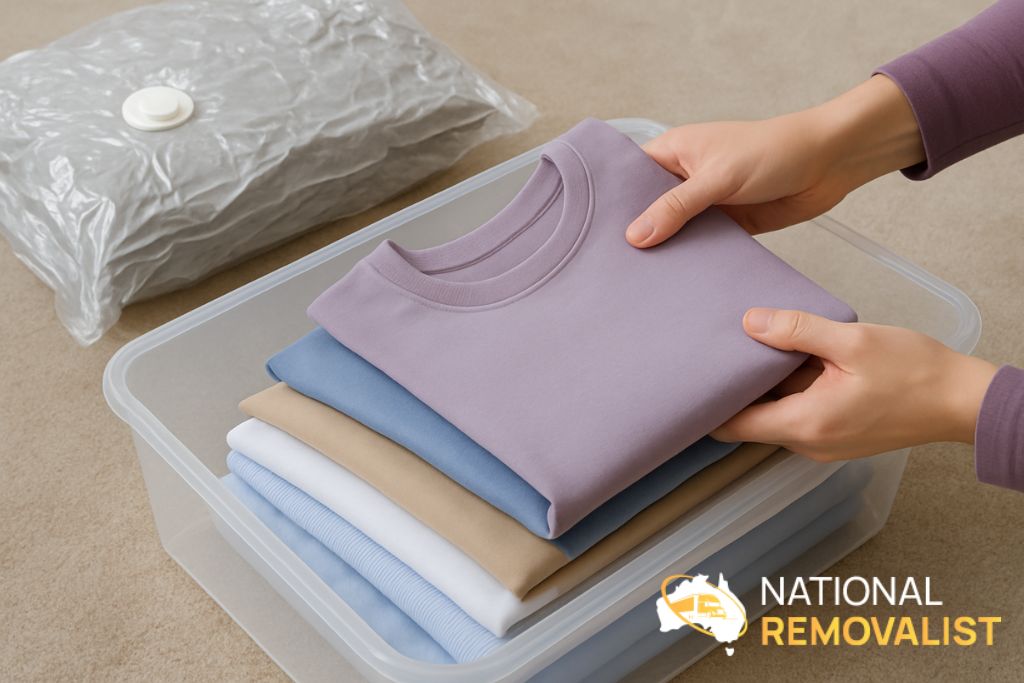House moving rarely just means transporting furniture. You have to take care of your other belongings too, like moving your fridge or your clothing. Clothes pose a unique problem for our belongings that many people do not realise. It’s not enough to shove them in a box; they can wrinkle, dust up, and get messy if you don’t handle them carefully.
We provide tips on packing your clothes for moving or storage, so you have minimal stress and the best organisation. You’ll get the information you need on how to pack clothes when moving so they are fresh and protected at their destination. We’ll help you declutter and use the best methods for packing clothes for moving seamlessly whether it’s a regional move in NSW, locally, or relocating interstate.
How to Pack Clothes When Moving: Pre-Packing Prep
Moving can be overwhelming, but a solid pre-packing prep strategy can make all the difference. The key is to sort, declutter, and strategise before touching a moving box.
Decluttering Before the Move
The most crucial step in efficient packing is ruthless decluttering. Less stuff means less to pack, move, and unpack!
The 3-Pile Method: Keep, Donate, Store
An effective way to declutter is by the popular 3-pile method:
- Keep: These are the things you know you’ll need and use as you settle into your new place.
- Donate: You should put anything in this pile that you don’t need or want but is still in good shape. You may choose to give your belongings to local charities, thrift stores, or friends and family.
- Store: When you want to save items you don’t plan to reach for often, a separate storage place is perfect, like you might for sentimental things, off-season pieces or seldom-used appliances. This is most useful when considering how to pack clothes for storage.
If clothes are damaged beyond repair, disposing it properly is your only option. Our rubbish removal services can be of help.

Categorising Clothing for Efficient Packing
Once you’ve decluttered, the next step is categorising your remaining clothing. This makes unpacking a breeze and helps you decide the best way to pack clothes when moving.
- Everyday wear: Place these goods close together and make them quick to find. You’ll use them as soon as you move.
- Formal clothes: Improper treatment may cause wrinkles, so storing them in wardrobe boxes is wise.
- Seasonal items: After clearing out, group things you’ll use only in certain seasons. For example, if your move occurs in summer, your winter coats should go in a “seasonal storage” box.
- Sentimental or storage-only pieces: These items belong in your “Store” pile. Ensure they are properly protected for long-term storage.
If you pre-pack your items in advance, you’ll make your move much less stressful and easier.
How to Pack Clothes When Moving: Packing Methods Based on Clothing Type
When your wardrobe is clean and organised, you can move on to putting things into your bags. How you handle your clothing depends on the type to keep them looking good after moving. We’ll cover the smartest packing methods depending on the clothes you are taking.
Everyday and Foldables: The KonMari Packing Technique
The Konmari approach can really change how you organise your daily clothes, such as t-shirts, jeans, and folds. The main idea is to fold clothes vertically so they stack high and are easy to see when you arrive, making everything fast to unpack and put in order.
- Rolling vs Folding for T-shirts, Jeans, etc.: When rolling items for travelling in suitcases is good, a modified KonMari is more helpful when moving in boxes. You need to make the clothes into tidy rectangles with enough stability to stand independently. It doesn’t just save space; it also cuts down on wrinkles in your clothes compared to packing them directly into a box.
- Packing Cubes and Compression Bags: These are your best friends when considering how to pack clothes and the best way to pack clothes for moving.
- Packing cubes helps organise clothes by type (e.g., all t-shirts in one cube and socks in another). They make it easy to transfer directly into drawers at your new home.
- Compression bags are handy for common things that don’t need delicate handling. Using a vacuum, they take the air out, drastically reducing your clothes size. This trick helps use the space inside moving boxes in the best way possible.
Delicate or Formal Wear
Formal attire, silks, lace, and other delicate fabrics require extra care to prevent wrinkles, snags, and damage.
- Garment Bags: If you want to keep your formal wear wrinkle-free, you should use special garment bags. When making a local move, you might simply hang your clothes in the wardrobe box so they don’t need to be folded and can be moved while holding up. This is the best way to pack clothes for formal occasions when moving.
- Tissue Wrapping: You should use tissue paper to carefully wrap small pieces that won’t fit into a garment bag. Use soft tissue paper that does not contain acid to keep your items from creasing and becoming snagged.
- Suitcase Packing Strategies: When bringing delicate things, try packing your suitcase more carefully. Start with your stronger items, and on top, specifically lay down your delicate pieces, if possible, with a layer of tissue paper underneath. Don’t haul too much with you—overpacking can lead to collapse.
Bulky Items: Jackets, Coats, and Sweaters
Bulky items can quickly fill up boxes, making them heavy and inefficient.
- Vacuum-Seal Bags vs. Box-Packing: This is where how to pack clothes for storage and packing clothes for moving converge.
- Winter coats, puffer jackets and thick sweaters should be put in vacuum-seal bags to save space. They reduce the volume of items, so fewer containers are needed for packing and storage.
- If you choose not to use vacuum bags, fold bulky items neatly and pack them in sturdy boxes, trying not to overstuff them.
- How to Prevent Mustiness if Going into Storage: When using vacuum-seal bags or packing bulky items for long-term storage, moisture is the enemy.
- Ensure all clothes are completely dry before packing.
- To help dry out the air and prevent pests, place silica gel packets or cedar blocks in the boxes or containers you’re storing.

Moving Hanging Clothes Without Wrinkles
Among our fears while moving clothes is that our hanging items will become wrinkled. Luckily, you can use some tips to help your clothes get to your new home without collecting wrinkles.
Closet-to-Closet: Best Way to Move Hanging Clothes
For perfectly smooth clothes, the idea is to move your clothes without causing them too much disturbance.
- Use Wardrobe Boxes: Hanging clothes boxes are built to hold your garments from a metal bar inside. Most find that they can be the best way to move hanging clothes. Move your hang-up clothes to the wardrobe box with the hangers still on. With this method, you don’t fold your clothes, helping to avoid creases. You need these to know how to move clothes on hangers.
- DIY Hanging Racks: If boxes for your clothes aren’t available, make a DIY hanging rack in the moving truck or van. Connect a tension rod or a strong rope right across the body of the vehicle. Add small rods to the back of the door and quickly hang your laundry on them. Secure the clothes so they won’t move around too much during the trip.
- How to Bundle Hangers with Garbage Bags or Zip Ties: This is a popular and cost-effective DIY method for how to move clothes on hangers.
- Leave your clothes hanging up on the hangers.
- Take 5-10 hangers for the clothing you want to fold.
- Hold down the bottom of the clothes and carefully slide a large bag up. Wrap the bag’s drawstring around the hanger hooks and pull it shut. Sometimes, using a zip tie or rubber band around the neck of the bag onto the hooks will secure the bag. By doing this, your clothes are kept covered and relatively still, which stops most wrinkles from occurring.
- In addition, you might want to lay the tied clothes flat in an ordinary moving box for even more safety.
Smart Packing by Transportation Method
Selecting the proper method for moving your things will impact how you pack your clothes. Matching your packing approach to your transport style can make your trip faster and easier on the wallet.
DIY Moving: Packing Clothes for a Car or Rental Truck
If you are not hiring a moving company, every spare inch you can find in your moving truck rental is important.
- Maximise Trunk Space with Suitcases: If your luggage can be squashed or wrapped up into a roll, suitcases will keep them safe and neat. They help you travel with everything you need as they load and unload quickly from a trunk or rental truck. Bunch your clothes several layers thick to help them fit and stay wrinkle-free. This is the most important tip on how to pack clothes for moving. They help keep your belongings clean and safe from little scrapes and scratches on the trip.
- Use Laundry Baskets for Last-Minute Items: Don’t forget to use your laundry baskets! If you’ve just packed that last-minute item or a fresh outfit for after you arrive, stick it in the front pocket. Such bags are good for things that can easily fit in, such as a couple of towels or a stack of jeans. If you’re packing under time pressure or need to access some things quickly, this packing clothes for moving tips is for you.

How to Pack Clothes for Storage (Short-Term or Long-Term)
Whether you’re downsizing, decluttering, or just need to free up some closet space, storing clothes requires a thoughtful approach to ensure they remain pristine. The duration of storage—short-term or long-term—influences the best practices for packing clothes for storage.
Whether you’re storing items for a smaller home or just trying to fix overstuffed closets, taking care of your clothes is important. How long the clothes will remain in storage determines the best way to pack clothes for storage practices.
Label by Season and Frequency of Use
Labelling your belongings smartly gives you a more organised way to keep them.
- Label by Season: If you put away your off-season things, put labels on boxes or bins that read “Winter Wear,” “Summer Essentials,” or “Blend for Spring/Fall.” So, when it’s time to change your clothes with the seasons, you won’t have to work through all of them.
- Label by Frequency of Use: If you wear formal wear very infrequently, label such items as “Formal Attire (Rarely Used),” or if they have special meaning, use “Sentimental Items.” Because of this, you don’t end up digging in bins full of items you won’t use for what you’re searching for. How you label your things is key to successfully packing clothes for storage.
Best Practices for Keeping Clothes Fresh Over Time
Along with storage boxes and labels, a few tips will keep your apparel clean and odour-free.
- Clean Everything Thoroughly: No exceptions are allowed. Be sure to clean and dry every item of clothing before you store it. Small bits of dirt, food molecules, and facial oil can bring pests, damage linen, or produce a stain or mildew on the fabric. You should still wash or send clean clothes to the dry cleaner.
- Avoid Overpacking Bins: Don’t cram your storage bins so much that air cannot pass through them. Packing too much in your clothes bag can cause your clothes to wrinkle and reduce the success of moisture absorbers.
- Consider Cedar or Lavender Sachets: Natural ways to fight off moths and enjoy a nice scent are to put cedar blocks, cedar balls or dried lavender sachets inside your storage bins. Refrain from using mothballs because their strong smell is hard to remove.
- Store in a Climate-Controlled Environment (If Possible): The perfect place to store your clothes is somewhere not hot, bright or humid. A garage, attic or basement is likely to get extremely hot or cold and damp, which can spoil cloth items. It’s best to pick a climate-controlled storage unit for valuables or sentimental objects. It helps your clothing last longer and is the best way to pack your clothes for storage.

Final Tips for a Wrinkle-Free, Organised Arrival
Moving is happening today, and because you packed carefully, the task is now to make your entry into your new home easy. These tips will guide you to finish moving in neatly so your new home feels comfortable more quickly.
Unpack Priority Clothing First
Upon arrival, resist the urge to just open any box. Strategise your unpacking to get essential items readily available.
- Identify “First Night” Essentials: You must have these things in your wardrobe immediately. Remember to pack sets of clothes for everyone, including pajamas, toiletries, and any uniforms needed for tomorrow. These items, such as personal medications, should have been set aside in so-called Open First or Essentials boxes.
- Target Seasonal & Everyday Wear: Once you have the essentials set, concentrate on appropriately moving the season’s clothing into your rooms. In no time, things will feel the same again, and you won’t have to look for your essential clothing. This is a crucial aspect of the best way to pack clothes for a seamless post-move experience.
Use a Laundry Bag for Worn-But-Not-Dirty Clothes
Inevitably, during the packing and moving process, you’ll accumulate clothes that aren’t quite dirty enough for the wash but that you don’t want to put back in a clean drawer.
- Designated “In-Between” Bag: Keep a large, empty laundry bag or hamper easily accessible. Place these “worn-but-not-dirty” items directly into this bag as you unpack. This prevents them from prematurely cluttering your clean clothes or getting mixed into the laundry pile.
- Streamline Your First Laundry Day: When you finally get around to your first load of laundry, this bag will be a neat collection of items that need a refresh, making the task much more organised.
Your Clothes Deserve a Smooth Move
Moving your closet doesn’t have to lead to a disorderly tangle. We’ve seen that the key is to have a plan: pack according to what clothes you own and the kind of move you’re undertaking. Every step you take, from the beginning of decluttering to the final unpacking, improves the appearance of your garments.
Think just as much about how your clothing will be packed as you would when packing things that easily break. They are something we buy, wear and often value for their stories and memories. Taking a bit more time to take care of them before you move makes it easier to preserve them and makes your first days in a new place more comfortable.
Having a hard time dealing with the idea of packing and then unpacking? National Removalist can take care of those burdens for you with our comprehensive moving services without you worrying about Sydney moving costs.
At National Removalist, we understand what it takes to make your move smooth. We will take care of packing and unpacking to ensure your belongings get as much attention as you give them.
Get in touch with National Removalist today to request a unique estimate for your move.


